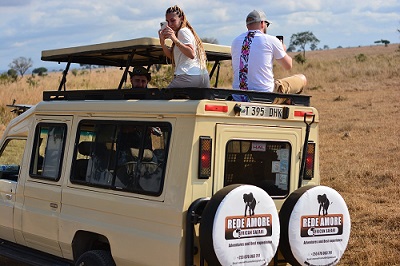
Most Seen Animals and Where to Spot Them on Tanzania Safari
Discover Tanzania’s top 12 safari animals from lions and elephants to flamingos and rhinos and learn the best national parks to spot them, including Serengeti, Ngorongoro, and Tara
Customer Reviews
4.9
12 Most Seen Animals and Where to Spot Them on Tanzania Safari
Tanzania is one of the most wildlife-rich countries on Earth a land where nature still rules. Each year, travelers come from all over the world to experience the wild heart of Africa.
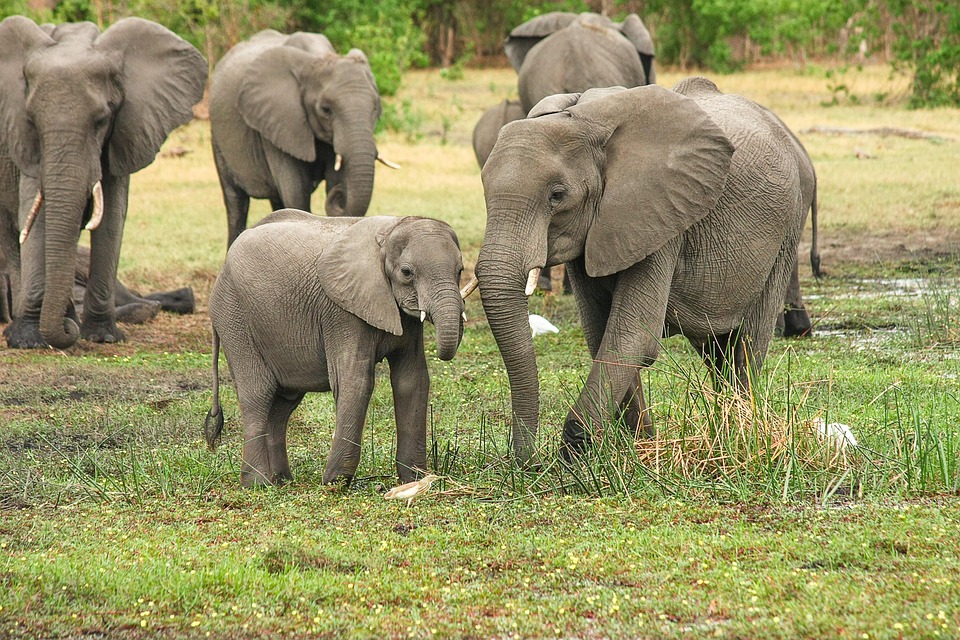
When you go on safari here, you’re not just watching animals; you’re entering their world. You’ll see lions resting under acacia trees, elephants walking silently across the golden savannah, zebras kicking up dust as they gallop in herds, and giraffes bending gracefully to drink from shimmering waterholes.
The experience goes beyond wildlife it’s about the feeling of freedom, the sound of the wind through tall grass, the orange glow of an African sunset, and the call of distant birds at dawn. Tanzania’s parks and reserves protect not only animals but also the ancient rhythm of life that has continued for thousands of years.
Whether you’re a first-time traveler or a seasoned safari lover, Tanzania welcomes you with open skies, endless plains, and unforgettable moments that stay in your heart forever.
Safari Region Overview Map
Tanzania’s wildlife destinations are grouped into three major safari circuits, each offering different landscapes, animals, and travel experiences. Knowing which circuit to explore helps you plan the perfect adventure.
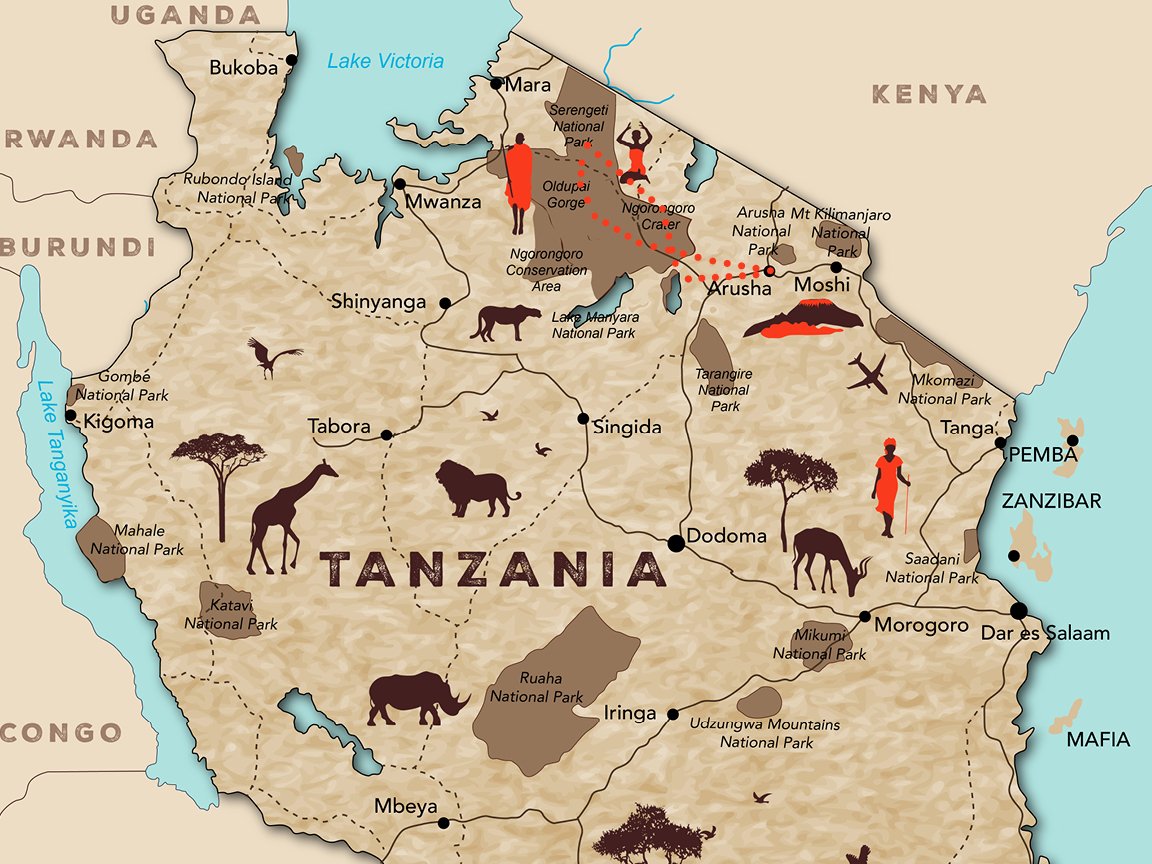
Northern Circuit
The Northern Circuit is Tanzania’s most famous and well-developed safari route perfect for first-time visitors. It includes the legendary Serengeti National Park, home of the Great Migration; the Ngorongoro Crater, a natural wildlife sanctuary often called “Africa’s Eden”; Tarangire National Park, known for its giant baobabs and large elephant herds; Lake Manyara, famous for tree-climbing lions; and Arusha National Park, a great day-trip option near Kilimanjaro.
This circuit offers easy access, stunning views, and a wide variety of animals all year round.
Southern Circuit
If you dream of a more private safari away from crowds, the Southern Circuit is ideal. It includes Ruaha National Park, a vast wilderness with dramatic landscapes and some of Africa’s largest populations of elephants and lions, and Mikumi National Park, where open plains and acacia woodlands attract zebras, giraffes, and buffaloes.
Here, the experience feels raw and authentic it’s where you can enjoy game drives with very few other vehicles in sight.
Western Circuit
For the truly adventurous, the Western Circuit is Tanzania’s wildest and most remote region. Katavi National Park offers an untouched, raw African wilderness filled with hippos, crocodiles, and huge herds of buffalo. In Mahale Mountains and Gombe Stream National Parks, the main stars are chimpanzees, where you can trek through rainforest-covered mountains and watch these intelligent primates up close.
This region is perfect for travelers who love off-the-beaten-path adventures and want to combine safaris with primate tracking and lake activities.
Below are the 12 most commonly seen animals in Tanzania each with its unique story, behavior, and the best national park to visit.
1. Lions – The Kings of the Savannah
Where to see them: Serengeti National Park, Ngorongoro Crater, Tarangire National Park.
Lions are symbols of strength and pride. In Tanzania, you’ll usually see them lying under trees during the day, as they prefer to hunt in the cool evening or early morning hours. The Serengeti is their kingdom over 3,000 lions roam freely there.
In the Ngorongoro Crater, lions are used to safari vehicles, so you can often watch them very closely. Sometimes you’ll even see lionesses with cubs, teaching them how to stalk prey. Tarangire, though less known, has strong prides too, often seen resting on rocky outcrops or in tall grass.
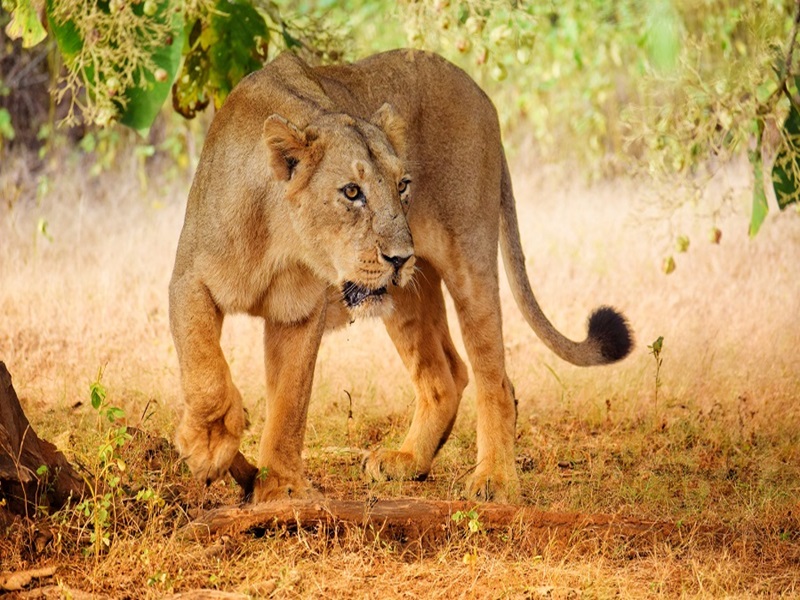
Fun fact: A lion’s roar can be heard from as far as 8 kilometers away!
2. Elephants – The Gentle Giants
Where to see them: Tarangire, Ruaha, and Serengeti National Parks.
Elephants are emotional and intelligent animals. They live in tight family groups led by an old female, called the matriarch. Tarangire National Park is known for its huge elephant herds, sometimes over 200 together, especially during the dry season (June to October).
In Ruaha, you can see massive bulls with long tusks walking quietly among ancient baobab trees a truly African scene. Watching them bathe, play, or protect their babies is always touching.

Tip: Visit during the dry season when elephants gather near rivers you’ll get amazing photo opportunities.
3. Giraffes – The Graceful Tall Ones
Where to see them: Serengeti, Lake Manyara, and Arusha National Park.
The giraffe, Tanzania’s national animal, is one of the most peaceful creatures to watch. They move slowly and elegantly, eating leaves from the tops of trees where no other animal can reach. In the Serengeti, you’ll often see them walking in small groups across open plains, their long necks standing out against the sky.
At Lake Manyara, they love the wooded areas, and in Arusha National Park, the contrast of giraffes against Mount Meru makes for unforgettable photos.
.jpg)
Fun fact: Even though giraffes are tall, they have the same number of neck bones as humans only seven.
4. Zebras – The Striped Beauties
Where to see them: Serengeti, Ngorongoro Crater, Tarangire National Park.
Zebras are among the most photographed animals in Tanzania because of their unique stripes. Each zebra’s pattern is different like a fingerprint. They’re social animals, usually seen in herds and often mixing with wildebeest for protection.
During the Great Migration, hundreds of thousands of zebras move alongside wildebeest across the Serengeti plains in search of fresh grass. The black and white stripes moving together look like waves in the distance.

Tip: Visit between December and June to witness the migration in the Serengeti or the Ndutu area.
5. Wildebeest – The Great Travelers
Where to see them: Serengeti and Ndutu (December to June).
Wildebeest are the stars of Tanzania’s Great Migration the largest animal movement on Earth. Over two million wildebeest, along with zebras and gazelles, follow the rain in a continuous circle between Tanzania and Kenya.
In the southern Serengeti and Ndutu (December to March), you can see thousands of calves being born it’s called the calving season. Later, they travel north, crossing rivers full of crocodiles in one of nature’s greatest dramas.
.jpg)
Fun fact: A newborn wildebeest can run just minutes after it’s born.
6. Leopards – The Silent Hunters
Where to see them: Serengeti, Ruaha, and Lake Manyara National Parks.
Leopards are shy and mysterious. They prefer to stay hidden in trees during the day, coming down to hunt at night. You’ll need sharp eyes and a good guide to spot them look for a long tail hanging from a tree branch.
Lake Manyara is famous for its tree-climbing leopards, while the Serengeti’s River areas are good for sightings too. If you see one up close, consider yourself very lucky it’s one of safari’s most thrilling moments.
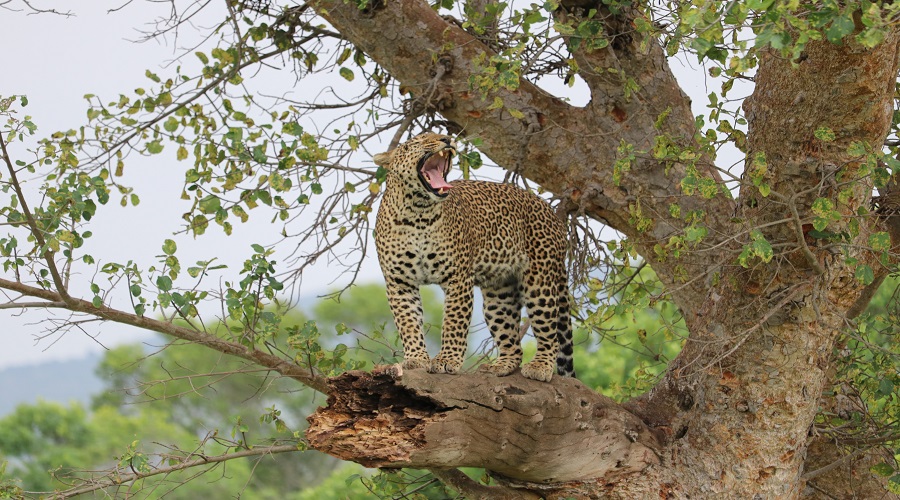
7. Cheetahs – The Speed Masters
Where to see them: Serengeti and Ndutu Plains.
Cheetahs are built for speed, capable of reaching 100 km/h in seconds. They hunt during the day, often seen standing on termite mounds or rocks to scan the plains for gazelles.
In the Serengeti, especially in the central and southern parts, cheetahs are fairly easy to spot because they like open grasslands. Watching a mother cheetah teaching her cubs to hunt is an unforgettable experience.
.jpg)
Tip: Visit between December and March when the grass is short cheetahs are easier to spot.
8. Hippos – The River Giants
Where to see them: Serengeti, Ngorongoro Crater, and Katavi National Park.
Hippos spend most of their lives in water it keeps their skin cool under the hot African sun. The Serengeti’s Hippo Pool is a favorite stop for many tourists. You can watch dozens of them packed together, grunting and splashing, sometimes fighting for space.
In the evenings, they come out to graze on grass and can walk several kilometers in a single night. Despite their heavy size, hippos are surprisingly fast on land.
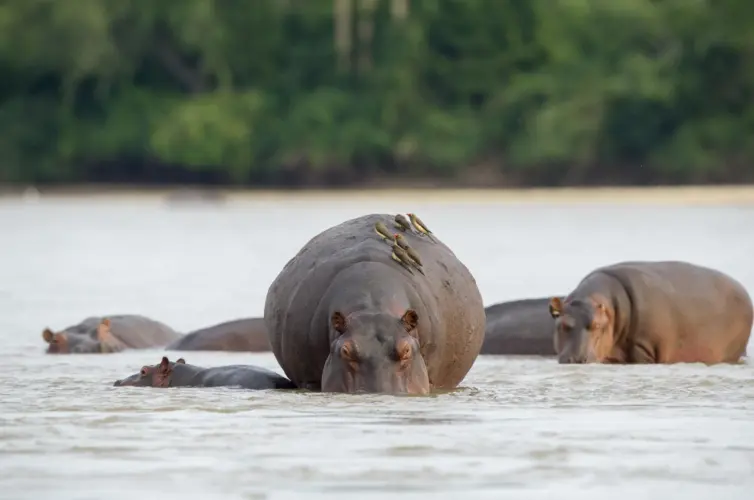
Warning: Hippos may look cute, but they are one of Africa’s most dangerous animals always admire them from a safe distance.
9. Buffaloes – The Powerful Grazers
Where to see them: Serengeti, Ngorongoro Crater, and Mikumi National Park.
Buffaloes are big, strong, and fearless. They move in large herds and are always alert for predators like lions. When threatened, they protect each other fiercely that’s why they’re part of the “Big Five.”
In the Ngorongoro Crater, you’ll see them grazing peacefully, often with birds sitting on their backs to eat insects. They may look calm, but they can be aggressive if disturbed, so guides always keep a safe distance.
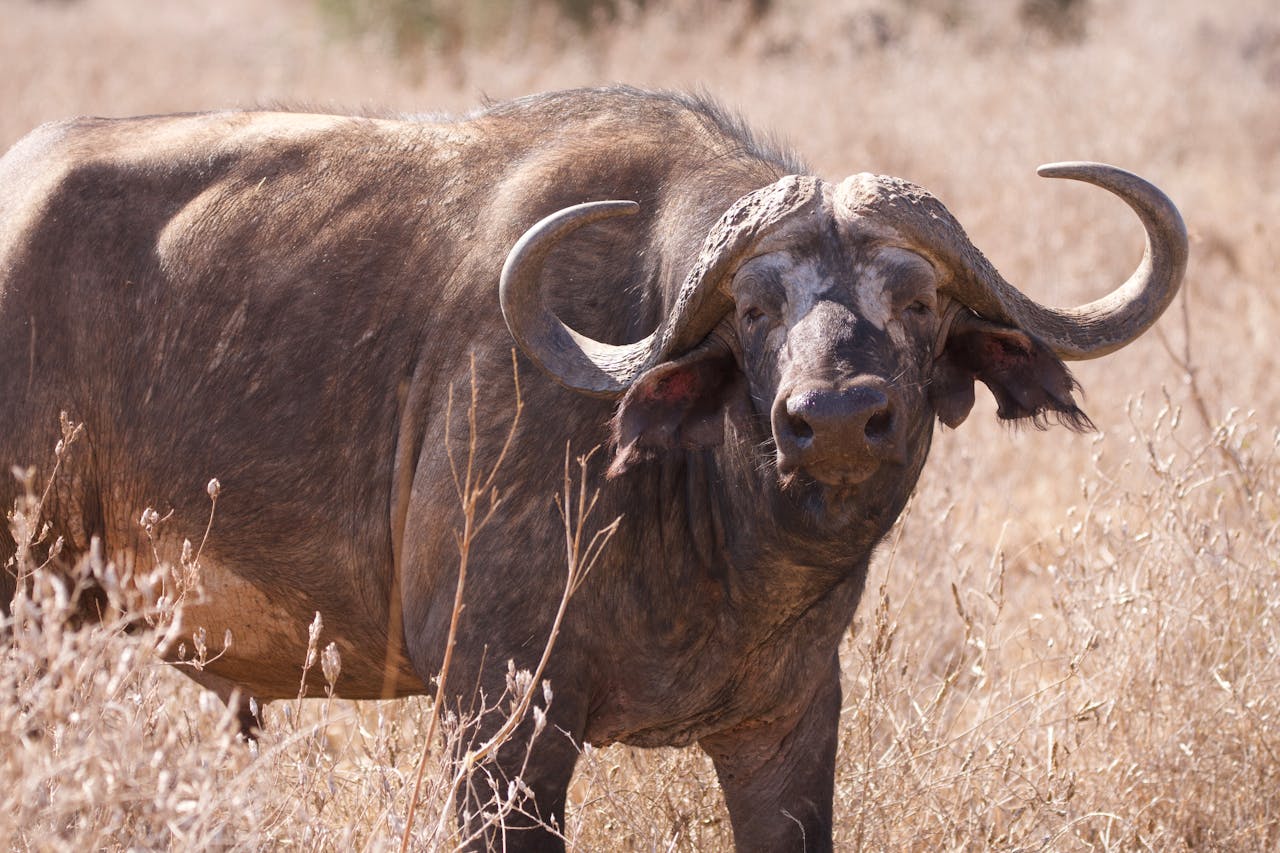
10. Rhinos – The Rare Treasures
Where to see them: Ngorongoro Crater and Serengeti (Moru Kopjes).
Rhinos are among the rarest animals in Tanzania. The black rhino is critically endangered, but small protected populations survive in Ngorongoro and Serengeti. Seeing one in the wild is a truly special moment it means you’ve seen all members of the “Big Five.”
They are usually solitary and prefer early morning or late evening walks. Rangers closely monitor them to protect them from poaching.
.jpg)
Fun fact: Despite their size, rhinos can run up to 50 km/h when threatened.
11. Baboons and Monkeys – The Playful Primates
Where to see them: Lake Manyara, Arusha, and Gombe Stream National Parks.
Baboons and monkeys bring life and humor to every safari. In Lake Manyara, you’ll see olive baboons near the roads or resting in trees. They live in big families and are always grooming or playing.
In Arusha National Park, blue monkeys and colobus monkeys swing gracefully through the forest canopy. For chimpanzees, visit Gombe Stream or Mahale Mountains, where you can trek into the forest to watch them up close a truly emotional experience.
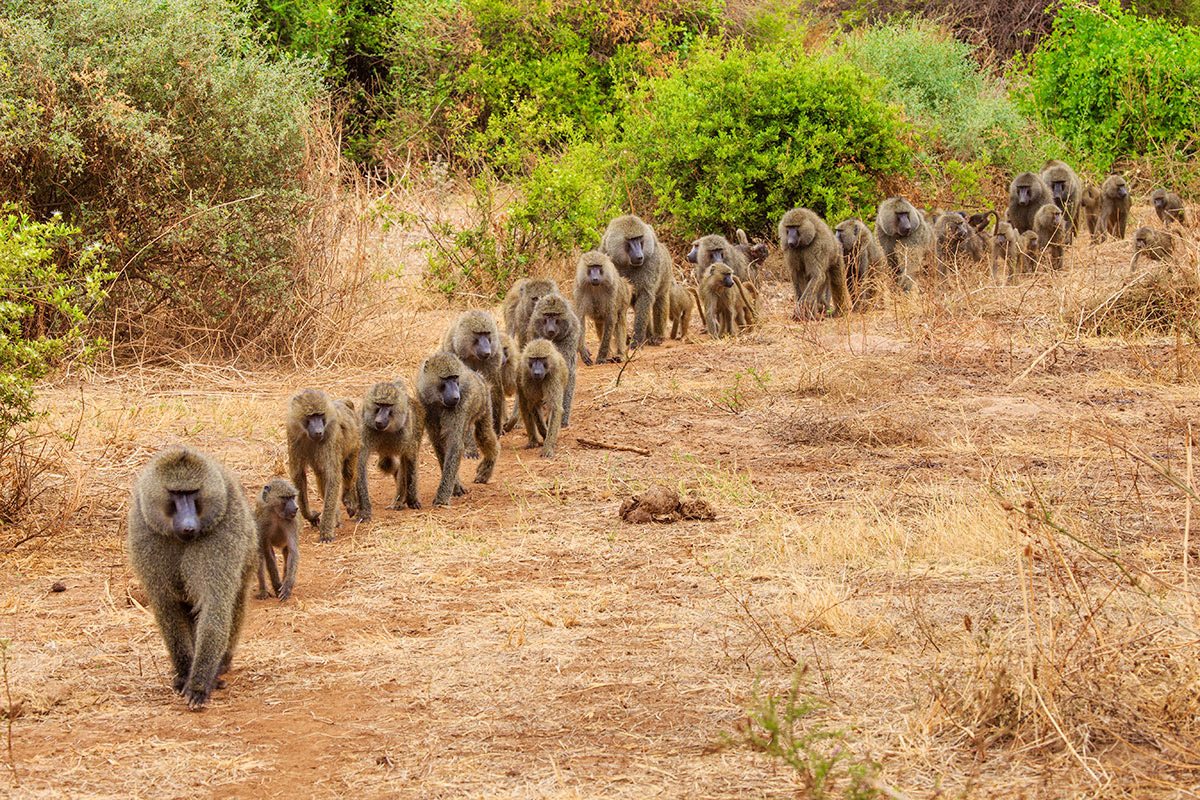
12. Flamingos – The Pink Birds of the Lakes
Where to see them: Lake Natron, Lake Manyara, and Ngorongoro Crater.
Flamingos are like flying flowers bright pink against the blue lakes. They gather by the thousands, feeding on algae and small crustaceans that give them their color.
Lake Natron is East Africa’s main breeding ground for lesser flamingos, while Lake Manyara offers a close look at them in shimmering waters surrounded by forests and cliffs.
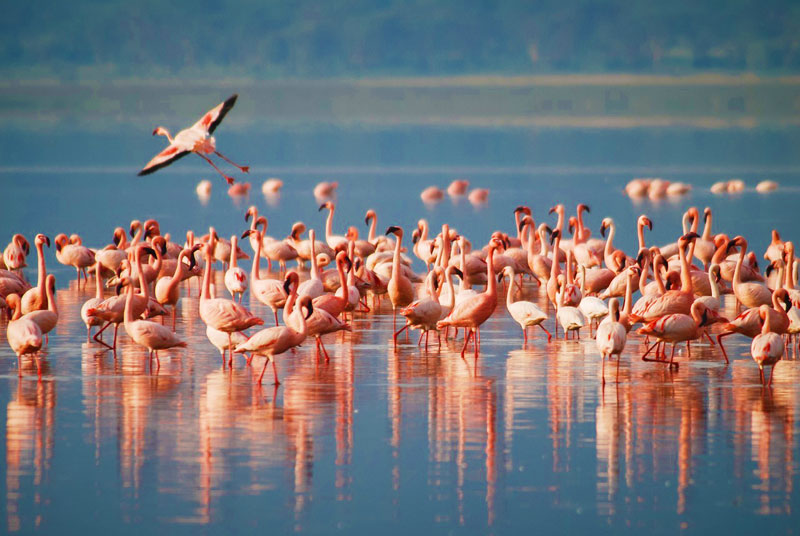
Tip: Visit during the dry season (June-October) when the water level is low and large flocks gather close to shore.
Some of Our Safari Itineraries to See Tanzania’s Most Iconic Animals
Whether you have just a few days or a full week, there’s always a way to experience Tanzania’s incredible wildlife. Below are sample safari routes that help you spot many of the 12 most seen animals lions, elephants, giraffes, zebras, leopards, cheetahs, buffalo, wildebeest, hippos, crocodiles, rhinos, and flamingos in their natural habitats.
3-Day Tanzania Highlights Safari
Destinations: Tarangire National Park, Ngorongoro Crater
Perfect for: Travelers with limited time who want to see the Big Five quickly.
- Day 1: Arrive in Arusha and drive to Tarangire National Park. See large elephant herds, giraffes, zebras, and lions resting beneath baobab trees.
- Day 2: Early morning drive to the Ngorongoro Crater, one of Africa’s densest wildlife areas. Spot rhinos, buffalo, hippos, wildebeest, and flamingos on the lake.
- Day 3: Return to Arusha after a short cultural stop at a Maasai village.
Common animals: Elephants, lions, rhinos, zebras, buffalo.
5-Day Classic Northern Circuit Safari
Destinations: Tarangire, Serengeti, Ngorongoro Crater
Perfect for: Guests who want to see the Great Migration and Big Cats.
- Day 1: Start from Arusha to Tarangire National Park for elephants, giraffes, and colorful birds.
- Day 2–3: Drive to the world-famous Serengeti National Park the best place for lions, cheetahs, leopards, and the Great Migration (wildebeest and zebras).
- Day 4: Explore the Ngorongoro Crater, spotting endangered black rhinos, hippos, and flamingos.
- Day 5: Return to Arusha with scenic stops along the Rift Valley.
Common animals: Lions, leopards, cheetahs, wildebeest, zebras, rhinos.
7-Day Ultimate Wildlife & Culture Safari
Destinations: Lake Manyara, Serengeti, Ngorongoro Crater, Tarangire
Perfect for: Families or photographers who want time to explore and relax.
- Day 1: Arrival in Arusha and drive to Lake Manyara National Park, famous for tree-climbing lions and flamingos.
- Day 2–4: Continue to the Serengeti Plains, where you’ll witness predators hunting and huge herds of wildebeest.
- Day 5: Game drive in the Ngorongoro Crater, home to rhinos, buffalo, and hippos.
- Day 6–7: End in Tarangire National Park, observing elephants, giraffes, and big cats before returning to Arusha.
Common animals: Tree-climbing lions, elephants, hippos, flamingos, giraffes.
10-Day Southern Tanzania Wilderness Safari
Destinations: Mikumi & Ruaha National Parks
Perfect for: Adventurous travelers looking for a quieter, wilder experience.
- Day 1: Arrive in Dar es Salaam and transfer to Mikumi National Park.
- Day 2–3: Enjoy game drives in Mikumi, spotting zebras, giraffes, and lions across vast plains.
- Day 4–8: Move on to Ruaha National Park, famous for its rugged beauty and huge populations of elephants, lions, and leopards.
- Day 9: Relax at your lodge or take a guided nature walk.
Common animals: Elephants, lions, leopards, zebras, giraffes, buffalo.
Add-On Option: Western Tanzania Chimpanzee Trek
Destinations: Mahale Mountains or Gombe Stream
Combine your safari with a journey to see chimpanzees Tanzania’s most intelligent residents. Trek through lush rainforests on the shores of Lake Tanganyika and watch these fascinating primates up close.
Common animals: Chimpanzees, monkeys, hippos, crocodiles, and colorful forest birds.
Each of these itineraries can be customized based on your travel dates, budget, and interests. Whether you want to follow the Great Migration, photograph the Big Five, or enjoy peaceful moments in untouched nature Tanzania has a safari waiting for you.
By us Make Your Tanzania Safari Unforgettable
A safari in Tanzania isn’t just about seeing animals it’s about connection. You’ll wake up to the sound of distant lions, share stories by a campfire under the stars, and watch nature unfold in front of your eyes.
Our expert team designs tailor-made safaris that fit your travel style, time, and budget. Whether you dream of luxury lodges or classic tented camps, family trips or honeymoon adventures we’ve got you covered.
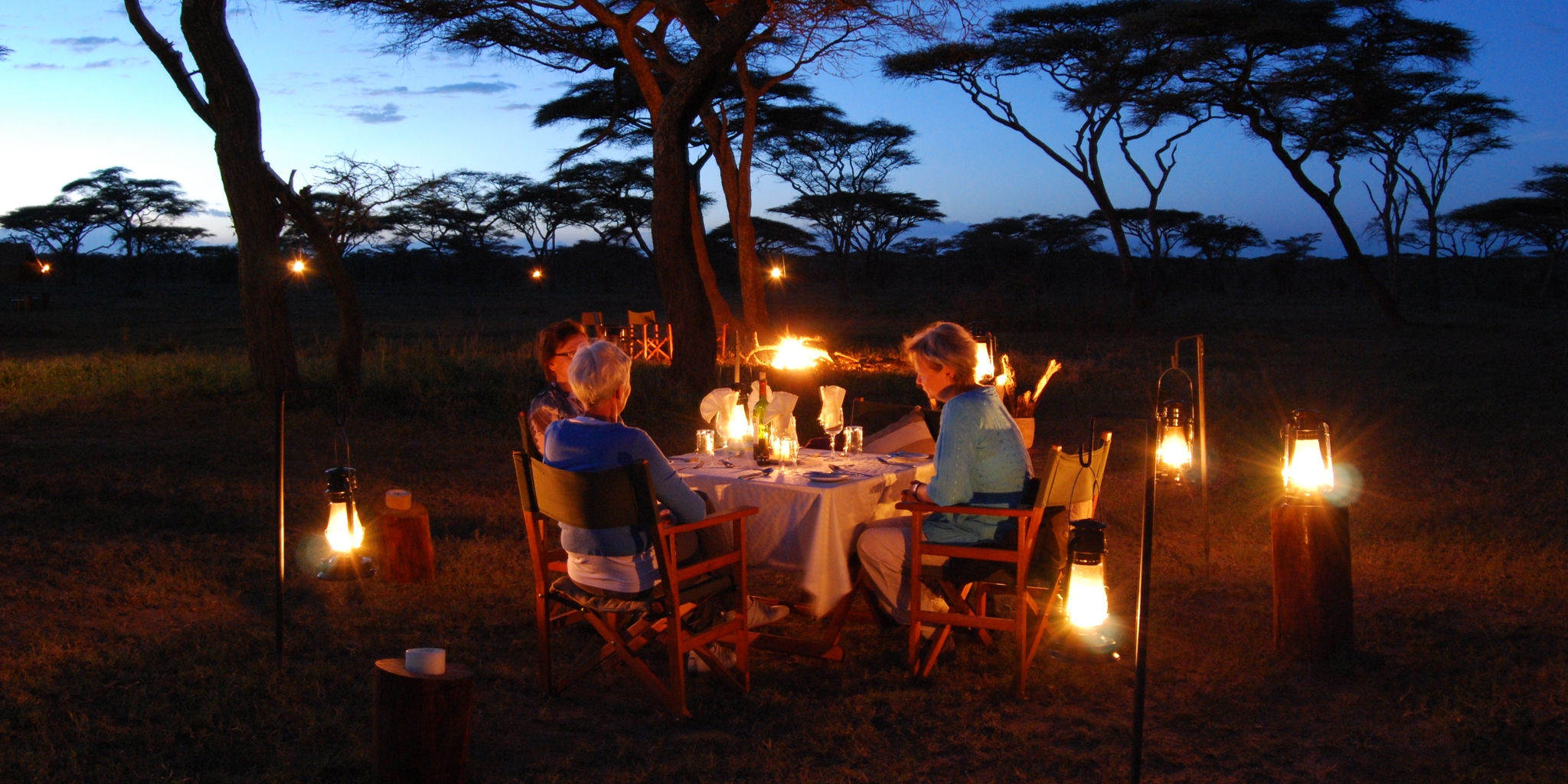
Why Book with Us?
- Licensed local tour operator with years of safari experience
- Professional English-speaking guides
- Comfortable 4x4 safari vehicles with open roofs
- Custom itineraries (from 3 to 14 days)
- Secure payment and flexible booking
Traveler Reviews after Booking with us
Aug 2025 • Couples
“The safari was much better than we expected. We had the opportunity to see the Big Five of Africa. It was a fantastic experience. I'd especially like to thank our driver, Jason, for providing such excellent guidance. The transfer and flight were also excellent. By the way, we even got to watch a lion hunt; I don't think there's anything else to say.” – Berat K
Aug 2025 • Family
“We did a one-day safari to Nyerere (Selous) with Rede tours safari, and it was an incredible experience.
They are very reactive while booking the trip via WhatsApp, and take the time to answer to all our questions. I will recommend them at 100% to everyone who wants to experience this journey.
The safari was just amazing. Our guide and driver were Nelson and Aziz, and they did all the best so we can see as many animals as we can.” – Aida Z

Frequently Questions Asked about Tanzania Safari
When is the best time to see wildlife in Tanzania?
The dry season (June–October) offers the best wildlife viewing animals gather near waterholes, and vegetation is low.
Can I see all 12 animals in one trip?
Yes! A 5–7-day Northern Circuit safari usually includes lions, elephants, giraffes, zebras, wildebeest, buffalo, and more. Rhinos and flamingos can be seen in Ngorongoro Crater.
Is Tanzania good for first-time safari visitors?
Absolutely! Tanzania’s parks are safe, well-organized, and offer some of Africa’s richest wildlife diversity.
Tips for the Best Safari Experience in Tanzania
- Bring binoculars, a hat, and sunscreen.
- Always listen to your guide’s safety instructions.
- Early morning and late afternoon are the best times for wildlife viewing.
- Stay patient every sighting is unique.
Every safari in Tanzania is unique nature never repeats the same scene twice. One day you may see a lioness hunting; the next, elephants bathing or giraffes silhouetted against the sunset.
That’s what makes Tanzania so special it’s pure, wild, and endlessly surprising.
Whether you go to the Serengeti, Ngorongoro Crater, Tarangire, Ruaha, or Lake Manyara, you’ll meet these twelve amazing animals and witness life in its most natural form.
A Tanzania safari isn’t just a trip it’s a journey into the heart of nature, where every moment tells a story.